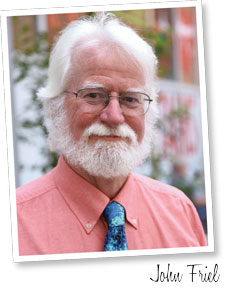12/1/2023
Evolution
John Friel

Well, I’ve done it, sort of. Become more of a gardener, that is. At any rate, I seem to be finding lots of overdue things to do outside, like planting more bulbs.
My latest feat: Whacking back an overgrown Spirea japonica Shirobana to make room for a favorite, Aralia Sun King. The Shirobana had been in the ground for at least 20 years, gradually expanding its territory all the while. It was a hard cutback: The original plant had pushed out three or four satellites.
In the process, I found among the roots of the mother plant, the original plastic picture tag. Save for a chipped corner and a little fading, it was intact and perfectly legible. Which is impressive, but also a little scary, isn’t it?
Thanks to a century or so of proliferation, petrochemical products are quite literally everywhere. A recent New York Times article tracks author A.J. Jacobs’ struggle to go a single day without using or even touching any plastics. Despite his best intentions and heroic efforts—he made his own deodorant, paid in cash with exact change, took a folding wooden chair onto the subway, used a bamboo/horsehair toothbrush (eww!)—he failed 164 times in 24 hours.
It's not all that surprising. We’ve all got plastics in our homes, cars, closets, wallets and now—thanks to litter degrading into microplastics and infiltrating air, soil and sea—our bodies. And nobody really knows if that’s a huge problem, a small one or no big deal. We’re all guinea pigs in a massive experiment. Even Jacobs’ “Keep the Sea Plastic Free!” T-shirt turned out to be 10% polyester.
I know, I know: There are vast upsides to plastics. They serve many functions better than any other material. They helped us win WWII. I’ve paddled plastic boats for decades. Even the hull of the “stripper” canoe I just built is essentially wood sealed in fiberglass-reinforced resin.
The green industries could not have grown to their present proportions without petrochemicals in every facet: greenhouse cover, machine parts, weed barrier, irrigation, cold-chain packaging and, of course, containers, to name a few. I’ve worked in glass houses, but even I’m not old enough to have manhandled plants grown in clay pots filled with steam-sterilized real soil, carried in wooden flats. It’s been a quarter of a century since Steve Hutton, then owner of Conard-Pyle, declared, “We don’t grow in soil. We grow in oil.” And it’s much truer now than it was then.
But doesn’t 20 years seem like overkill for a shrub tag’s survival? Hines, the nursery that grew the plant in question, has since gone through massive changes—bankruptcy, buyouts, extinction. But the shrub, and its tag, live on. Now, most of the plant is mulch and the tag is on its way
to a landfill. But big picture, is that really better? One way or another, rapidly or slowly, that tag’s molecules will make their way to the ocean.
Elsewhere on the property, my firewood pile has grown to epic proportions. If I don’t stack another billet, I have enough BTUs stockpiled to heat my home for three years. It’s gratifying to look at, a very secure feeling.
A good bit of my stash is ash, courtesy of neighbors victimized by the Emerald Ash Borer, whose signature hieroglyphic tunnels lend a more queasy, frown-inspiring sensation. I’m happy to have the fuel, but I’d rather have the healthy trees. And I have to wonder … between EAB, Dutch Elm Disease, Sudden Oak Death and Chestnut blight, what force has more profoundly changed the American tree canopy in post-Columbian times—pests and pathogens, or the logger’s axe?
Some of you in Oregon or California probably just said “Drought!” or “Fire!” out loud, but those implications and ramifications are too large and fraught for me today.
I need to go water the aralia. We’ve had a dry spell since it went into the ground and it’s still getting settled, putting down roots in its new home after a shamefully long stint, including last winter, in its black pot.
I want it to answer the bell come Spring 2024. Hope isn’t just the thing with feathers; it also has golden leaves. GP
John Friel is a freelance writer with more than 40 years of experience in horticulture.